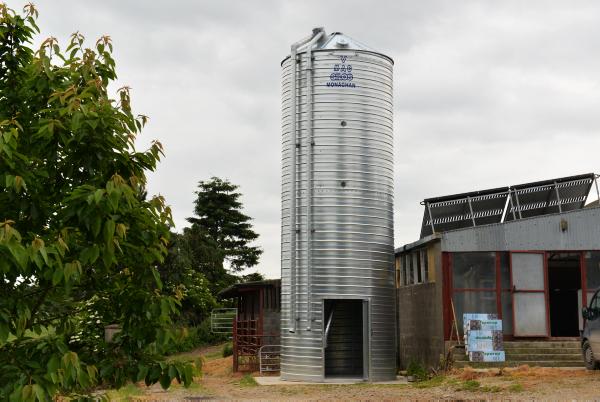This week I feature a bulk meal bin installed to allow in-parlour feeding of dairy cows. It’s on the farm of Brendan Meade of Stamullen, Co Meath. He wanted to reduce the work involved in feeding meals to his spring-calving herd. “We used to blow nuts into a shed and then feed them out with a root chopper, on top of mangers,” he says. It was another job in a busy day. Now the nuts are augered from the new bin straight into the parlour.
There’s also less handling of the cows. “In spring, freshly calved cows are on half-ration. They had to be pulled out and that was a two-man job. I wanted to be able to feed individually in the parlour.’’ The new setup allows him do that.
Brendan looked at a number of feed bins and in the end bought a V-mac feed bin from McAree Engineering, plus a Dairymaster in- parlour feeding system from Cookstown Dairy Services.
Picture one
Brendan went for a fully enclosed 20t feed silo. “The closed base is handy. Invariably you have calves and weanlings getting nuts. It’s typically three or four fertilizer bags. It’s handy to have somewhere to store them.”
Picture two
Bulk feed bins stand on a concrete pad. McAree recommend that for a 20t bin the pad is 12ft square (3.6m x 3.6m), 300mm thick and made with 35N concrete. No reinforcing steel is required.
After the pad is cured, the silo will arrive on the back of a lorry. To be able to withstand wind when empty the bin is bolted to the concrete pad.
“The bin was up and fixed in place in three-quarters of an hour.”
Brendan then poured a 35mm (1.5in) concrete screed inside, level with the base ring of the bin. So the floor of the store sits higher than the surrounding pad, ensuring that rain water does not come in. Feed bins can be set up to empty into front-loader buckets, parlour augers, trailer augers, barrows, bags or even diet feeders. Brendan went for two exits points at the bottom of his bin – one for the parlour auger, the other a bag filler.
The doorway is wide enough to allow a good-sized meal barrow wheel in. The door closes over and is vermin and weather proof. McAree Engineering placed the filler and breather pipes for easiest access by the meal lorry.
Picture three
Here we see the auger box supplying feed to the parlour. The location where Brendan sited his bin is low relative to the parlour. Therefore, to minimise bends and to keep the auger as straight as possible, Cookstown advised Brendan to keep the auger box relatively high off the ground. To facilitate this McAree fabricated the bin with longer than normal legs.
Picture four
McAree Engineering fit inspection windows on the bottom cone of their bins. When the bin is empty the farmer can look in with a torch to check for any bridging of damp feed. This could occur if feed is warm and not fully dry when blown into a bin.
Picture five
Brendan already had mangers on hand for his six-unit parlour. He needed to purchase the screw augers, overhead feed hoppers, down pipes and computerised controls.
The in-parlour feeding system was installed in one day. Feed was delivered that afternoon and the system got up and running. “The only problem was that the first evening the cows didn’t want to come in. It took three hours to do that first milking. Mind you, they learned very quickly that there were nuts in there and now they’re pushing to get in.”
Picture six
Brendan is happy with his bin and auger system. It has reduced labour and gives good control over meal feeding. The list price for a McAree Engineering 20t store bin like this is €3,700 plus VAT plus delivery. The company’s bins are spiral-rolled into a cylinder, meaning there are minimal joints. It manufactures split bins for storing two types of feed.






 This is a subscriber-only article
This is a subscriber-only article










SHARING OPTIONS: